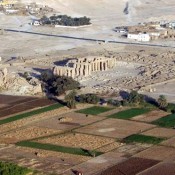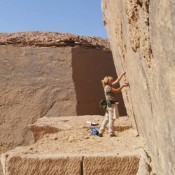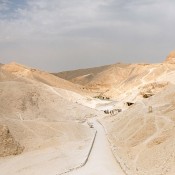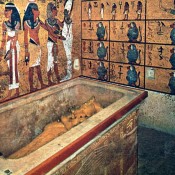Researchers have unearthed one of the world’s oldest Egyptian sun dials – possibly dating back to 13th century BC – used by the people to tell time with the position of the Sun.
The sun-dial can be described as a flattened piece of limestone (so-called Ostracon) on which a semicircle in black colour had been drawn. The semicircle is divided into twelve sections of about 15 degrees each. A dent in the middle of the approximately 16 centimetre long horizontal baseline served to insert a wooden or metal bolt that would cast a shadow to show the hours of the day. Small dots in the middle of each section were used for even more detailed time measuring.
The discovery was made during archaeological excavations in the Valley of the Kings, near Luxor, Egypt by a team of researchers from the University of Basel led by Professor Susanne Bickel. The piece was found when clearing debris on the east side of tomb KV 61. This area must have been originally occupied by workmen’s huts in the Ramesside Period (roughly the 13th century BC). The sundial was found next to these workers huts and would have been possibly used by those employed in the construction of the tombs to measure the working hours during the day.
However, the division of the sun path into hours also played a crucial role in the so-called netherworld guides that were drawn onto the walls of the royal tombs. These guides are illustrated texts that chronologically describe the nightly progression of the sun-god through the underworld. Thus, the sun dial could also have served to further visualise this phenomenon, researchers said.
During this year’s excavation in cooperation with the Egyptian authorities and with the help of students of the University of Basel over 500 mostly fragmentary objects that had been recovered in former seasons were documented and prepared for further scientific examination. This also includes all the material of the lower strata of tomb KV 64 found in 2012. Inside the roughly 3500 year old tomb Basel researchers had discovered a sarcophagus that was holding the mummy of a woman named Nehemes-Bastet.






